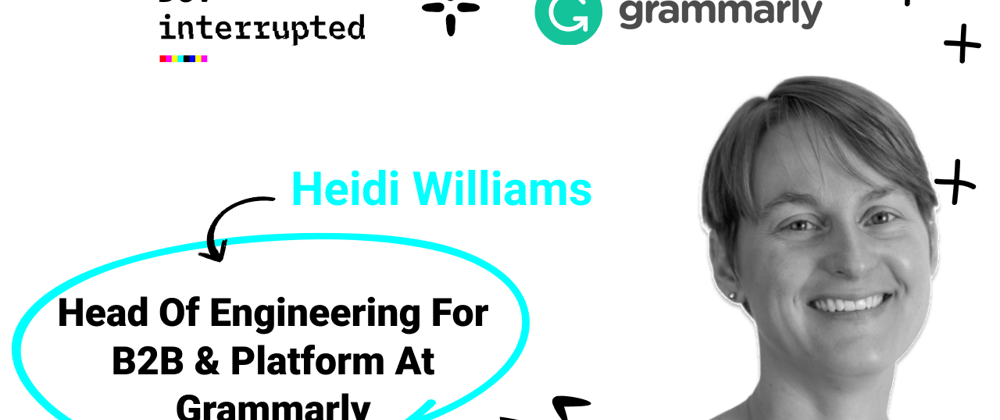This article was written exclusively for devinterrupted.com by Heidi Williams
.
.
.
Grammarly has a simple but ambitious mission: to improve lives by improving communication. Every day, our AI-powered writing assistance helps 30,000 teams and 30 million people communicate clearly and effectively wherever they write.
But behind our technology is a team of engineers. Until recently, our engineers focused exclusively on building a product for consumers. When I came aboard to lead new initiatives as the Director of Engineering for Grammarly Business and Grammarly for Developers (expanding our product to support teams, organizations, and third-party developers), it was clear Grammarly approached full-on hypergrowth.
Then the pandemic changed everything. Suddenly, we found ourselves transitioning to a remote-first organization amid hypergrowth hiring and onboarding. The company doubled in the past year to over 500 team members, and my teams have grown even faster.
To be successful, we needed to spearhead initiatives that solved two problems. The first involved people: How could we successfully maintain a culture reflecting Grammarly’s EAGER values in a remote world? The second was technical: What tools and practices would enable our team members to thrive?
Transitioning to remote
Historically, Grammarly has had an in-person culture. We have four hubs—in Kyiv, San Francisco, Vancouver, and New York. But when I joined in July 2020, everyone was remote. Few assumed it would stay that way, but the “return to normal” kept getting pushed further back. Eventually, Grammarly adopted a remote-first hybrid model.
With “remote-first,” Grammarly team members work primarily from home. However, we continue to believe in-person interaction builds trusting relationships and a supportive culture that fosters innovation. So our offices became collaboration hubs where face-to-face meetups will also take place each quarter. We made this decision based on our progression as a company; because we felt we’d learned how to communicate and collaborate effectively and saw advantages to the remote-first model.
Keeping it personal
I look forward to meeting people in person at our first team-based meetup next year, but with my quickly growing team split between Kyiv and North America, we need to constantly build and maintain personal connections.
“I've onboarded fully remotely. I've only met four of my coworkers in person.” - Dev Interrupted podcast at 19:33
Thus, we’ve tried our best to foster a thoughtful approach to team bonding at Grammarly—which signals that breaks and fun are important, too.
Some example approaches:
- Events celebrating everyone’s individuality and encouraging personal connections
- Coffee/donut chats, compliments of Grammarly
- Virtual hackathons
Our events motivate people to break from work and connect with each other. Activities range from educational to creative and silly, including an Indian cooking class during Diwali, a graffiti workshop, a cocktail class, a Halloween costume competition, and Grammarly’s twelfth-anniversary talent show. This personable approach also translates to how we chose the tools for remote collaboration.
Finding the proper tools
Setting hypergrowth teams up for success requires investing in the right tools and processes. As often as possible, we try to implement asynchronous communication and development best practices. Proper tools that facilitate organizational transparency are critical for alignment in a remote-first company.
Fewer people are required in Zoom calls because we share recordings and notes in open Slack channels. For collaboration and stakeholder alignment, our Engineering teams use Confluence for documentation, Jira for issue tracking, and Figma for collaborative interface design. Architecture and whiteboard sessions occur in Miro, while team retrospectives happen in Parabol.
The archival component of these tools is invaluable; new and old team members alike can discover information through Glean, which gives us aggregated search across all our tools and content.
Embracing the talent diversity potential of remote work
One of the most exciting opportunities with remote work is in finding hidden talent in overlooked geographies. Silicon Valley gets all the attention, but it’s not the only region with great software engineers. There’s plenty of talent out there just waiting to be found.
“Genius is evenly distributed by Zip Code, but opportunity is not” - Mitch Kapor, Kapor Capital
Finding talent in other locations also leads to more organizational diversity. Whether that diversity is racial, ethnic, socioeconomic, or generational, diverse teams are going to improve your product. I’m a huge believer in diverse teams for two reasons:
- Better problem-solving than homogenous teams: I’ve witnessed this in my career, and it’s been proven with studies. Creativity naturally flows from visible and invisible diversity. Companies embracing differences will achieve better outcomes because the ensuing creative conflict helps you innovate and build better products.
- Stronger empathy for the customer: In Grammarly’s case, building writing assistance for the world’s 1 billion English speakers makes diversity in engineering critical. For example, those speaking English as a second language often visualize the language differently, leading to feature ideas that wouldn’t occur to primary English speakers.
You need a diverse team to build the right product for a broad audience. We’re excited to use recruiting tools like SeekOut and partner with organizations like Elpha and AfroTech to help us connect with and hire engineers from underrepresented groups.
Onboarding
But hiring isn’t enough! Many organizations are too focused on hiring, at the cost of onboarding. How we onboard folks and make them feel welcome is critical to their long-term success at Grammarly.
A small test of our onboarding process is whether new engineers can push code in the first week. If they can, it’s a signal the dev environment is well documented and has minimal friction. The faster people can be productive, the more confident they feel, which ultimately boosts team morale.
That said, onboarding is about more than pushing code. Engineers are encouraged to meet people and learn the product before they feel pressure to deliver. New engineers have a Getting Started Guide that includes who to meet and links to resources. Managers check in daily to answer questions. They also pair with a non-engineering Culture Buddy plus a mentor from their team so they can get to know all aspects of Grammarly life.
Thoughtful onboarding during hypergrowth helps new team members build connections, which leads to better team health in the long term.
Staying Grounded
My advice to any organization about to engage in hypergrowth is to remain thoughtful. Think about hiring, onboarding, your processes, how you measure success, and how you want your employees to feel when they join your team.
Remember, too, that diversity is more than a checkmark or an abstract goal. Diverse teams will be your strongest asset. They will push creative boundaries—and in doing so will build the best possible product with the best possible outcomes.
_
Want to join us in helping 30,000 teams at thousands of companies succeed through effective communication? We’re currently hiring for roles across the Grammarly Business and Grammarly for Developers teams.
If you haven’t already joined the best developer discord out there, WYD?
Look, I know we talk about it a lot but we love our developer discord community. With over 2000 members, the Dev Interrupted Discord Community is the best place for Engineering Leaders to engage in daily conversation. No salespeople allowed. Join the community >>








Oldest comments (4)
In a rapidly scaling world these are some good tips, thanks Heidi!
The Donut 🍩 program is awesome 😃
Great article. I wish the company were more open minded in general and made a concerted effort to offer a well-priced API. It's a real detriment to the startup and MVP community among so many others.
Stellar article and an even better interview on the podcast. Heidi is incredibly astute.